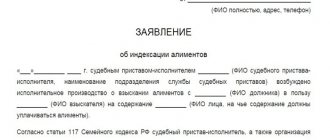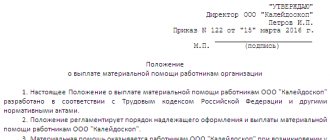Home / Alimony / Calculation of alimony from wages
If divorce allows a husband and wife to relieve themselves of their obligations towards each other, it does not allow this to be done towards a child. Paying child support is fulfilling your parental obligations. Ideally, the child’s parents themselves can calculate and determine the terms of payment of alimony. Otherwise, the procedure for forced calculation and deduction of alimony from wages provided for by law will be used.
What determines the amount of child support for one child?
The government does not set a fixed amount that the child support provider must pay to his children every month. The amount of payments is influenced by a number of reasons and factors. However, a person who is planning to file a lawsuit or has received a writ of execution can figure out how child support is calculated and the approximate amount to expect.
The amount that children remaining after divorce will receive monthly depends on the following factors:
- Is the decision to pay voluntary? If the divorce is more or less amicable and both parents understand their responsibility in raising children, they can independently agree on how much the other parent should pay. In this case, the amount may not depend on the income of the former spouse. However, it should not be less than the minimum wage adopted in the region of residence of the child.
- If alimony is assigned after filing an application with the court, then a variety of factors will be taken into account: the level of income of the parent, the immediate needs of the child. If he has health problems, the amount of payments will be larger. If the parent himself is a non-working disabled person, you can only count on minimal deductions from his benefit.
The calculation of alimony and its calculation will be made on the basis of the Federal Law “On Enforcement Proceedings” and under Article 113 of the Family Code. In order to start making payments from the salary, you need a statement from the parent himself, if this is his voluntary decision, an agreement sealed by a notary. If alimony is paid by court, then a court decision and a writ of execution issued on its basis, and a court order will be required.
Calculation example
Ivanov P.I., by court decision, pays an amount equal to 2 subsistence minimums established for the city of Moscow.
In 2021, when the court made this decision, its figure was 13,300 rubles. Consequently, Ivanov P.I. paid 26,600 rubles.
In 2021, the indicators have increased, and the minimum is now 13938. To calculate the indexation level, you need 26,600: 13,300 * 13,938 = 27,664.
There is another way to calculate indexation. We determine the ratio of the new minimum indicator to the old one and multiply by the amount of established payments:
- 13 938 : 13300 = 1,04
- 1.04 * 26600 = 27664 rub.
Either way, the amount will be the same.
Let's take a closer look at examples of how alimony is calculated in different situations.
Example of calculation for one child
Let's look at an example of how child support is calculated for one child. The general procedure looks like this:
- The employee is paid his salary for the period worked (month) in accordance with his position and employment contract.
- A tax of 13% is withheld from the salary.
- The calculation of alimony under a writ of execution or a notarial agreement is made from the remaining amount.
- The funds received are transferred to the specified account.
An employee of one of the enterprises has a salary of 45,000 rubles per month under an employment contract. It is necessary to calculate the deductions for his child who has not reached the age of majority. According to the writ of execution, their amount should be 25% of income. In addition, the employee is entitled to a tax deduction of 1,400 rubles.
- To calculate the amount on which tax will be withheld, you need to subtract the amount of tax deduction from your salary: 45,000 – 1,400 = 43,600 rubles.
- We calculate the tax: 43,600 * 13% = 5,668 rubles.
- We determine the amount of net income: 43,600 – 5668 = 39,332 rubles.
- Alimony will be calculated from this amount. Their size is equal to a quarter of income. This means 39,332 * 25% = 9883 rubles. - the amount that must be transferred to support the child.
- The employee’s salary will ultimately be: 39,332 – 9883 = 29,449 rubles.
For two children
Deductions in favor of two children are calculated in the same way. However, in this case, a tax deduction is provided for everyone, that is, 1,400 * 2 = 2,800 rubles are subtracted from the salary before calculating personal income tax. And the percentage of alimony is 33% of income.
- 45,000 – 2800 = 42,200 rub.
- 42,200 * 13% = 5,486 rubles. – Personal income tax
- 45,000 – 5486 = 39,514 rubles.
- 39,514 * 33% = 13,039 rubles. – child support for two children
As a result, the employee will receive “clean”, without deductions and taxes - 38,211 rubles.
For three children
If an employee has three or more children, then he is obliged to transfer half of his income to their maintenance. The tax deduction is 1,400 rubles for two children and 300 rubles for a third child. That is, 5,800 rubles are deducted from the salary before taxation:
- 45,000 – 5800 = 39,200 rub. – taxable part.
- Personal income tax from it will be 5096 rubles.
- 45,000 – 5096 = 39,904 rubles. is the employee's income. Child support will be calculated from this amount:
- 39,904 : 2 = 19,952 – these are the funds that will be transferred to the children.
And the same amount is due to the employee.
Calculation for less than a month
If the writ of execution contains the date from which alimony is calculated, and it does not coincide with the calendar beginning of the month, then payments will be calculated from the day indicated in the document. Let's say it's April 20th.
There are 21 working days in April. Funds are credited within 9 working days.
- We calculate the employee’s income for this period, if his monthly salary is 40 thousand rubles: 40000: 21 * 9 = 17142.85
- Next, we calculate personal income tax: 17142.85 * 13% = 2228.57
- The salary for the billing period will be: 17,142.85 – 2228.57 = 14,914.28
- Payments for the child will be calculated from this:
14,914.28 * 25% = 3728.57 rub.
Accordingly, at the end of the month, the employee’s salary, after transferring the tax, will be reduced by this amount.
Arbitrage practice
Example 1
If the father pays child support voluntarily, then it is necessary to issue a receipt for each payment, or transfer it by bank transfer marked “Alimony.” But recently, bailiffs have begun to take into account transfers from the father’s account to the mother’s account, even if the purpose of the payment is not indicated.
Marina collected alimony from her ex-husband for her daughter by court order. The man did not have an official job, but regularly transferred money for his daughter to his ex-wife’s account. Over the course of several months, he transferred 218,050 rubles. In May, a quarrel occurred between the former spouses and the woman decided to collect arrears of alimony. To do this, she turned to the bailiffs for a certificate about the amount of debt. The bailiff calculated the debt, taking away the man's expenses for the child in the amount of 218,050 rubles. The woman filed an administrative application to challenge the certificate. She explained that this money was not alimony, it was transferred as voluntary financial assistance to the child. But the court did not share this point of view and refused to cancel the certificate (Decision No. 2A-3102/2018 2A-3102/2018~M-2975/2018 M-2975/2018 dated November 29, 2018 in case No. 2A-3102/2018 ).
No payer is immune from such a situation. Therefore, it is advisable to take a receipt, correctly draw up money transfers and promptly notify the bailiff about the payment of alimony.
Example 2
Often women want to collect alimony from the father of their children in the amount of the subsistence minimum. But the men are trying to challenge such a court decision. As an argument, they cite that mother and father are equal in matters of raising and maintaining the child. That is, they must provide a living wage for a child through joint efforts.
Olga filed a claim against her ex-husband to collect alimony in the form of a fixed payment. The man worked part-time at a car service station and had no regular income. She wanted to receive payments in the amount of the living wage. The court satisfied her demands. But the children's father filed an appeal to reduce the payment to 0.5 MMR, based on equality of parental responsibilities. The court of 2nd instance refused to satisfy the requirements, considering that the decision was made correctly (Decision No. 11-165/2018 of October 23, 2021 in case No. 11-165/2018).
We can conclude that despite the equality of rights and responsibilities of parents, the amount of alimony can be assigned in the form of the full subsistence minimum.
Responsibility for non-payment of alimony
Sometimes, after a divorce, one of the parents, not wanting to pay money for the maintenance of the children, begins to evade this responsibility in any way: does not report his whereabouts, works unofficially, or receives a salary equal to the minimum wage.
In this case, according to the law, there are two types of liability: civil and criminal. He bears civil liability for failure to comply with a notarial agreement or writ of execution.
For each day of non-payment, penalties are charged. The defendant must repay the resulting debt along with the amount due withholdings. The amount of the fine for non-payment of alimony is established on the basis of the Family Code.
In some cases, it is possible to contact bailiffs. They can block the alimony provider’s accounts or withdraw the required amount from them.
For malicious evasion of one's duties, the payment of fines or forced correctional labor, and even imprisonment are provided. The term of arrest and the amount of fines are determined by the court on the basis of the Criminal Code. Being punished does not exempt you from paying alimony, that is, a negligent parent, once released, is obliged to continue paying money to his children.
Documenting alimony payments: nuances
In order to effectively record obligations within the framework of enforcement proceedings, it makes sense for the employer to use separate accounting documents.
For the purposes under consideration, the employer may use:
1. Book of registration of writs of execution.
The fact is that for the loss of a writ of execution, an official of the employing company can be fined up to 2,500 rubles. (Article 431 of the Code of Civil Procedure of the Russian Federation). Therefore, the employer needs to appoint someone responsible for storing such documents and oblige him to use a special accounting book.
Writs of execution must be kept for 5 years, but not less than the period during which alimony payments are made, as well as another 3 years after the expiration of this period (Clause 1, Article 29 of the Law “On Accounting” dated December 6, 2011 No. 402-FZ, Clause 4 of Article 21 of Law 229-FZ).
2. Journal of alimony payments.
It makes sense to use such a document in order to generally improve the efficiency of accounting for transfers to an employee. The journal can classify such payments in various ways (for example, by the recipient’s marital status, by the method of calculating alimony - in a flat amount or as a percentage of earnings).
3. A form for notifying bailiffs about the fact of the debtor’s dismissal (and about his new place of work - if information about him is available).
The procedure for applying the first 2 documents should be fixed in the company’s accounting policy (clause 4 of PBU 1/2008).
Procedure for withholding alimony
Deductions are made by the employer's accounting department if the parent paying child support has an official salary. They are calculated from all types of earnings and from almost all benefits. The only exception may be the benefit that an employee receives in connection with the birth of a child.
The law also limits the amount of deductions. According to Article 138 of the Labor Code, they cannot account for more than half of the employee’s income. However, in some cases their size may be higher.
Example
An employee of the enterprise received 2 writs of execution. According to one, he must pay funds in favor of 3 children from his first marriage. The amount of deductions should be 50%.
According to the second, he must transfer 8 thousand rubles for the maintenance of his second wife.
The citizen’s income after paying 13% was 30,000 rubles.
The children should be deducted 15,000 rubles from him. And 8 thousand - for the second wife. The total amount of deductions should be 23 thousand, which significantly exceeds the 50% required by law. In cases where money is withheld in favor of minors, it is allowed to deduct up to 70% of income, which equals 21 thousand rubles. This amount will be divided proportionally between the two spouses:
- 21,000 * 15,000: 23,000 = 13,695.65 rubles. - will be received by the first wife of a citizen.
- 21,000 * 8000: 23,000 = 6,720 rubles. – alimony for the second wife.
- The remaining funds are 23,000 - 21,000 = 2,000 rubles - a debt that will be gradually paid.
If an employee also has deductions from wages based on writs of execution or fines, then first of all, alimony is always calculated and withheld.
Attention! If a citizen pays funds for the maintenance of children from different marriages, then all transfers are made simultaneously.
Write-off cost
For the recipient of alimony, the withholding procedure is completely free, and the payer of alimony pays all bank and other fees associated with the employer’s transfer of alimony to the recipient’s accounts (Clause 3, Article 98 of Law No. 229).
In addition, if the debtor has evaded paying alimony and is in debt, then an enforcement fee in the amount of 7% of such amount is imposed on the amount of the debt. Upon receipt of the writ of execution, the accounting department breaks down the entire amount of the enforcement fee evenly over the entire payment period.
How to calculate child support from a non-working parent
If, after a divorce, a wife files a lawsuit for alimony, then a writ of execution is sent to her husband’s place of work. Then the deduction of alimony from his wages is carried out by the accounting department of the enterprise where he works.
But if the father does not work, this does not relieve him of responsibility to the children. In case of official recognition as unemployed, funds will be deducted from unemployment benefits.
If the parent is an entrepreneur, then in this case, in order to calculate the amount, you need to know the specifics of taxation in the region of residence. If he submits an income tax return at the end of the year, payments are made based on this information.
If a simplified taxation system is in effect, then a scheme is used that determines the average salary in the region and from this the amount of payments per child is calculated.
Internet portals dedicated to legal topics contain online calculators that easily allow you to calculate the approximate amount of money owed for one child or several children.
Accounting department transfer deadlines
The amount of alimony must be transferred by the payer's employer no later than three working days from the date of payment of wages or other income that is subject to withholding (Article 109 of the RF IC).
The writ of execution on the payment of alimony received by the employer indicates the details of the recipient where the funds should be sent. In this case, the money is transferred by payment order, and the commission for the transfer of funds is paid by the alimony payer . If bank details are missing, but the recipient's address is available, then funds can be sent by postal order.
The accountant responsible for transferring alimony is liable if he does not fulfill his obligations within the established time frame. The bailiff checks not only the correctness of the amounts transferred, but also the timeliness of payments.









